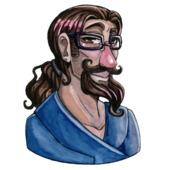The really old final fantasy games, from FF1 to FF6 (excluding the modern remakes) used tiles. FF7, FF8, and FF9 used pre-rendered images with 3D characters, afaik: static backgrounds, with multiple drawn layers so you could walk behind and under stuff, and with some animations drawn over it for things like blinking lights or sparkly water.
Tilesets are easy to use. Basically, imagine having an array that is 5 x 5 integers:
1 2 5 1 1
1 3 4 2 2 //Or whatever
1 1 2 2 2
1 2 2 2 2
1 2 2 2 2
Now imagine that everyplace a '1' is, you draw a grass image, and every place a '2' is you draw a dirt image, and '3' might be a rock, and '4' might be the bottom half of a tree, and '5' might be the top half of the tree.
Except instead of having a 5x5 map, your map might be 50 by 50 tiles or more, and you might have hundreds or thousands of different tiles (not just 1,2,3,4, and 5).
The benefit of this is that images take alot of space (each pixel takes 4 bytes when in videocard RAM), so even just a small 1024x1024 takes 4 megabytes in memory (much smaller when compressed as a file). Larger images (for even medium-sized maps) cost alot. But if you have a tilemap, you can build your backgrounds out of small images and do impressive things out of small amounts of memory. Plus, it makes map development much much easier and faster.
Another thing you can do is use freely placed images: the map is composed of dozens of images drawn at certain positions. A background, with a road drawn over it, some trees and rocks, and etc... with nothing snapped to the grid. So the map is composed of pairs of (position, image).








